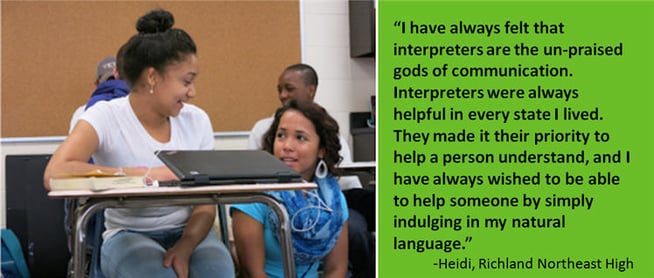Student Interpreters Make the Difference for Classmates
Written by:
You and Two

Reprinted with permission from You & Two.
By the middle of the first week of October, student interpreter Denis has given several tours to new students in Spanish, translated a parent letter and interpreted a phone conversation. Denis is one of 13 student interpreter who work at Richland Northeast and Spring Valley high schools, helping to bridge the language barrier between English and non-English-speakers. Nearly 8 percent of Richland Two's more than 27,000 students are Hispanic.
Denis didn't have access to an interpreter when she learned English in early elementary school in another state but wishes she had. She says the students and families she helps appreciate the effort.
"They feel more comfortable having someone who speaks their language, and it makes them open up to us more," she says.
Denis begins first period on Thursday, October 1, making runs for the Richland Northeast High Counseling Department. When she returns, Iris another interpreter, is on the phone with a parent. She lists the documents she will need to bring to the office to withdraw her son.
During the next period, senior, Heidi, spends some time interpreting for a student in class. The sophomore speaks very little English. Her teacher, Ms. Doyle says Heidi has been "an invaluable asset," to the student's improvement.
The English II class breaks into teams of two for a project. Following a list of questions on the whiteboard, students interview each other and then introduce their partner. Heidi kneels down next to the student's desk and speaks clearly into the student's ear. When it's time to present, the student gives her report in Spanish, and then Heidi translates. When she returns to the office, she immediately begins making phone calls scheduling appointments for families to pick up their Kajeet hotspot.
Later, she says she remembers what it was like to be surrounded by people speaking a language she didn't understand and is glad to be able to help students in that position now.
Preparing for Simultaneous Interpretation
During lunch at Spring Valley High, district Hispanic Family Liaison Ron Huff conducts a training for the student interpreters. He encourages the group to practice shadowing, repeating speech verbatim in their target language, at least once every other day for 15 minutes. It's preparation for simultaneous interpretation, a highly specialized area of translations, which requires accurate and complete translation, orally and at the same rate of speech as the speaker, with only a few seconds of lag time. This is the goal for each of the interpreters. An upcoming assignment requires students to read and translate an article about shadowing.
The group runs through a scenario with various students playing the role of student, interpreter and non-English speaking school official. "You can look directly at her," Mr. Huff tells a student and then turns to the rest of the group. "Remember that you as the interpreter make the other person present in the conversation." Mr. Huff then demonstrates simultaneous interpretation. After, students note that it seemed to take less time and felt more like a real conversation.
During fifth period in the School Counseling Department, junior Maria starts to work on Mr. Huff's assignment. She grew up speaking both English and Spanish at home and dreaming of becoming an interpreter.
"Being bilingual, to me, is a gift. It doesn’t matter what language you may know. Wherever you go someone may not know English and may need an interpreter," she says. "I am glad to be a part of this program, and I hope to help many families this school year."
Reaching Out to Parents
She and senior Amanda spend a portion of sixth period scheduling appointments for families to pick up their Kajeet hotspot. Amanda steps out to take a phone call on the Counseling line from parent looking for details about an upcoming event.
"I've been waiting for a program like this to start," Maria says. "When Ms. Ham told me about this, I was really excited because I knew I was going to be a part of it."
The girls discuss the test interpreters take to get certified. Amanda proudly shows off her certificate from LanguageLine Solutions, noting that she was just a few points from the professional level (5). To be eligible for the district student interpreters program, students must earn at least a 3 on the test. Five is the highest score. Amanda too has realized the benefit of being bilingual and hopes to use it to travel the world and learn about other cultures.
"I would also like to get my medical interpretation certificate next year with the goal of later obtaining the legal interpretation certification," says Amanda. She also studies French and plans to take up Mandarin in college.
Back in the Spring Valley Guidance conference room, the girls try simultaneous interpreting for the first time with Mr. Huff's guidance. After, he commends Maria for not getting flustered when she couldn't remember the translation of a particular word. "That's good. Because the other person is going to continue speaking, and you don't want to get stuck."
The student interpreters are one of six initiatives of Si Se Puede, an R2Innovates project whose mission is to extend efforts to equip staff and empower families, ensuring Latino student success. The name Si Se Puede translates to "Yes you can!" or "You can do it!"
The other initiatives are:
- Welcome Wagon - training front office staff in creating an inclusive environment
- Spanish for Educators - beginner and intermediate courses for teachers
- Fiesta Conexiones! - fall party to connect parents with school, district and local resources
- Latino Recruitment - seeking to hire a professional and support work staff that mirrors our community
- Spanish R2 App
Richland School District Two is a Kajeet customer.

